
|
Topic 4B:ARE WE UNIQUE?
Reading: Other Planetary Systems, The New Science of Distant Worlds, Chapter 10 |

|
Topic 4B:ARE WE UNIQUE?
Reading: Other Planetary Systems, The New Science of Distant Worlds, Chapter 10 |
The Nebular Theory offers a nice explanation for the formation of our Solar System. How universal is the Nebular Theory? Can it describe adequately planet formation everywhere in our home galaxy, the Mlky Way?
We are now in a position to start addressing these types of questions. Astronomers have discovered many extra-Solar planets and planetary systems over the last 25 years using a variety of methods. The methods may be broken down into direct searches for planets and indirect searches for planets.
The methods writen in magenta have found extra-Solar planetary systems. Spectroscopic and Transit (eclipse) searches have been the most successful and are the ones we concentrate on here.

The center-of-mass is where the sawhorse (fulcrum) must be placed in order for the two riders to balance each other. On a seesaw, the more massive person sits closer to the fulcrum than does the less massive person if we want to keep the seesaw in balance.
In planetry systems, we define the center-of-mass in the same way, however, because the star is usually much more massive than the planets, the center-of-mass lies very close to the star,
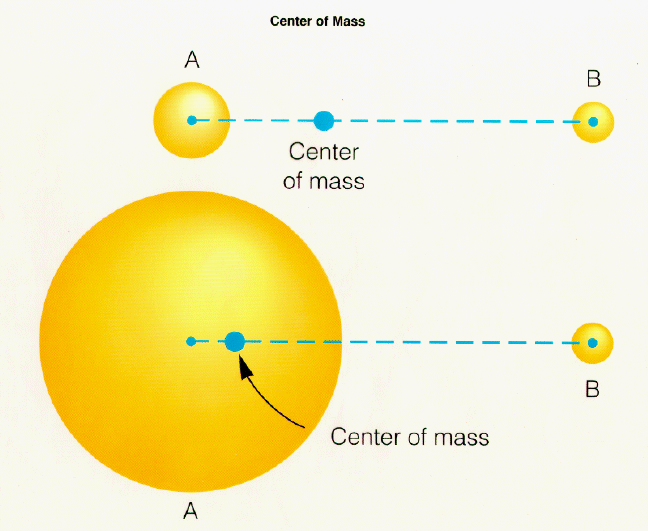
Astrometric searches try to detect directly the motion of the star. To get a feel for the difficulty of astrometric searches , suppose that we lived on the nearest star to the Earth (excluding the Sun), Proxima Centauri. Could we see our Solar System? Proxima Centauri is at a distance of 4.3 light years or 40 trillion kilometers from the Earth. This is a long way away -- the average distance the Earth is from the Sun is 1 Astronomical Unit which is 8.3 light minutes or 150 million kilometers -- Proxima Centauri is 270,000 Astronomical Units from the Sun.
Jupiter orbits in our Solar System in an orbit of size 5.2 A. U. with orbital period of 11.9 years. From the distance of Proxima Centauri this would correspond to an orbit of angular size ~ 0.004 arc-seconds. Recall 1 degree = 60 arc minutes. 1 arc-minute = 60 arc-seconds ===> 1 arc-second = 1/3,600 of a degree!! Given current technology for ground-based observatories, this is not do-able.
There are currently no good candidates based on astrometric searches. In the future, we will develop space-based experiments which will have pointing accuracies of better than 0.00001 arc seconds and thus will be able to see nearby planetary systems.
Spectroscopic searches try to detect evidence of the motion of the star by looking at changes in the light spectrum the star produces because of its orbital motion. To understand what is done, we introduce the phenomenon of Doppler Shift,
To show how this relates to planet searches, I will remind you of something about sunlight. Even though sunlight appears colorless, it is actually a blend of many different colors (wavelengths) as can be seen if we pass the light through a prism. We see the same effect naturally when the light from the Sun is spread out into a rainbow by water droplets in the air (acting as prisms).
  |
 |
Red light has a longer wavelength than does blue light.
 |
|
The big problem with direct detections of planets is that stars are
very bright and planets are very faint. This means that it is very
difficult to see planets in the glare of the stars. Furthermore,
because planets are small, direct detections of planets from eclipses
(transits) of stars by planets are not likely to lead to large changes
in the light output and so will be hard to see.* Kepler was
able to see changes in the brightness of a star to around 0.01 %, TESS is
not as sensitive as Kepler for individual stars, but TESS sampled a much
wider swath of the sky, 85 % coverage compared to 0.25 % coverage.
Kepler
and TESS (Transiting Exoplanet Survey
Satellite) have been very successful having discovered
thousands of planets and candidates.
Given the strengths of the
missions, Hot Jupiters were the first type of
planet found (by Kepler). Since then, however, Kepler and TESS have discovered
most of the known super-Earths and
mini-Neptunes, exploiting their greater ability to
detect earth-like planets compared to the spectrocscopic methods.
An aim of TESS, beyond discovery of planets, is to identify targets for future
observations by ground-based telescopes and the Webb space telescope.
Beyond utility as a path to planetary discovery, transits observed by Kepler and TESS lead to further information such as planetary radii, planetary masses, orbital properties, information on the atmospheres of the planets. A key result is that densities of the planets may be found from transits and potentially (when used in conjunction with ground-based and space-based telescopes) may shed light on the atmospheric composition of the planets.
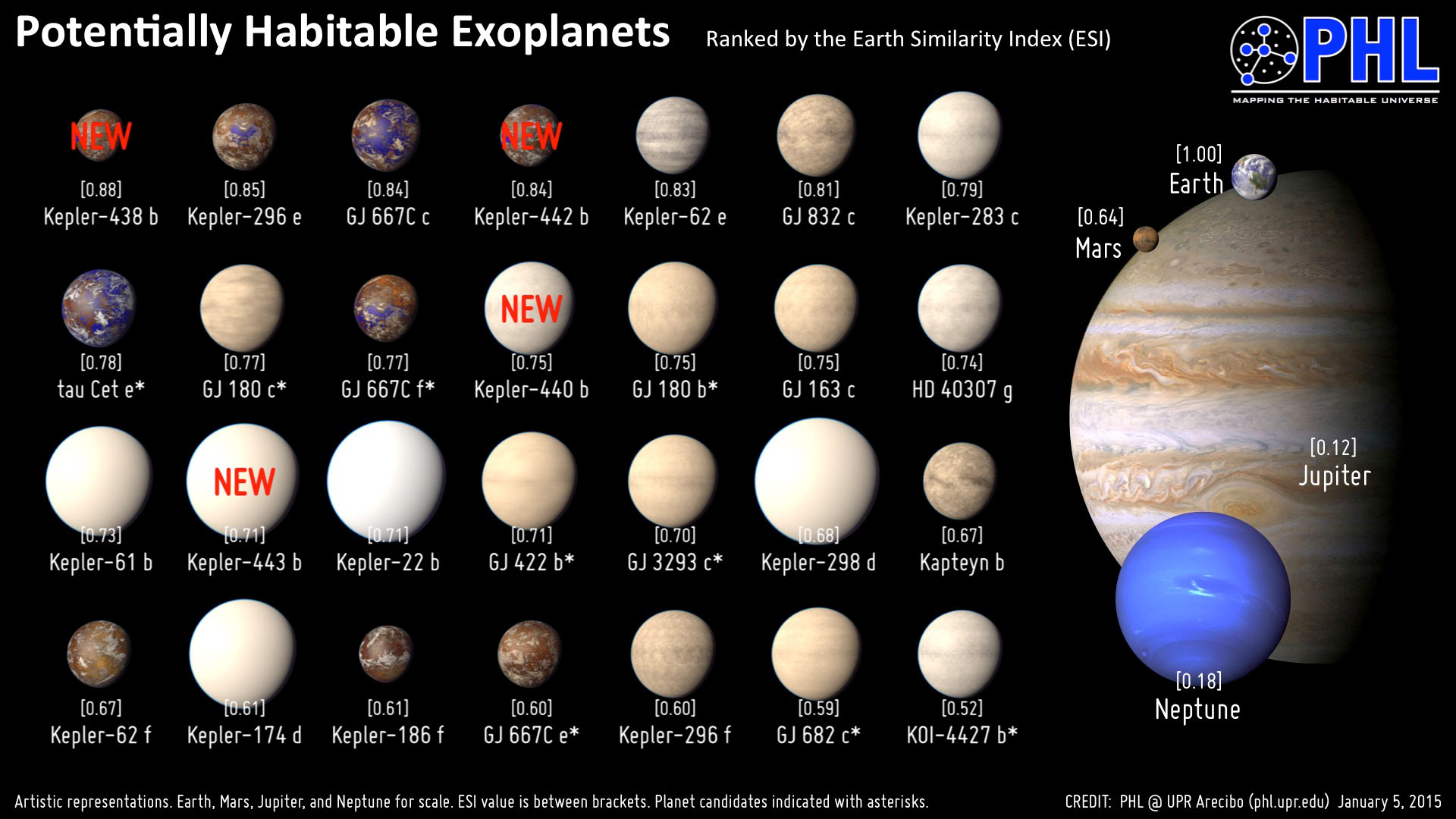 Click on image for a Kepler Orrery |
__________________
*We don't really see a planet during an eclipse, we see its
shadow as it moves across the star; we may be able, however, to
see the planet's
atmosphere as the light from the star shines through the atmosphere during the
transit or as it reflects off the planet's atmosphere.
An interesting discovery of an Earth-like planet in the constellation Sagittarius was made during a Dark Matter search. The planet was discovered using a technique that used gravitational microlensing. An Earth-like planet 5 times the mass of Earth with an orbital period of ~10 years was made.
To see the properties and relationships between the properties of the discovered planets, e.g., their orbital eccentricities, their masses and radii, the relation between their orbital periods and their orbital sizes (the semi-major axes of their orbits), and other correlations, go to the Exoplanets website and use their plotting tool to play with the data, as was done on Homework 3.
Bottom left: we show a plot of planetary masses versus how far the planets sit from their stars. Bottom right: we show how the planet's densities compare to their masses.
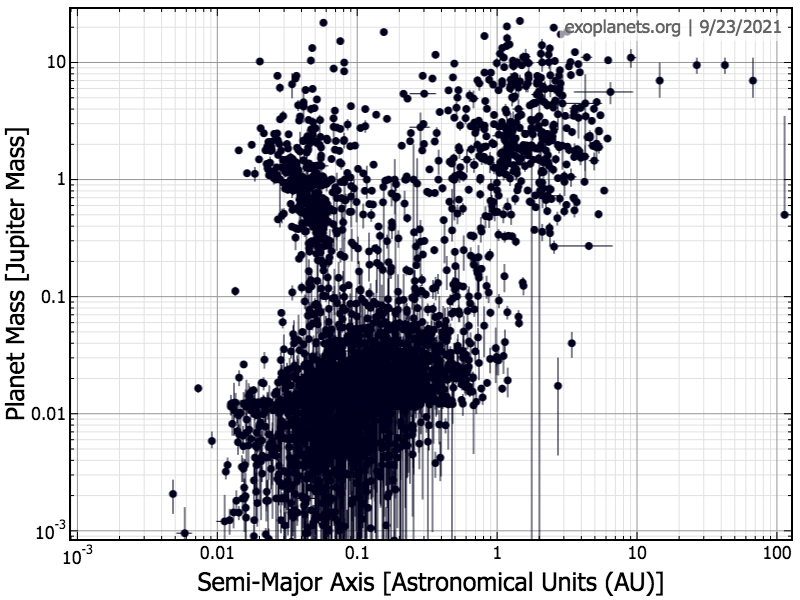
|
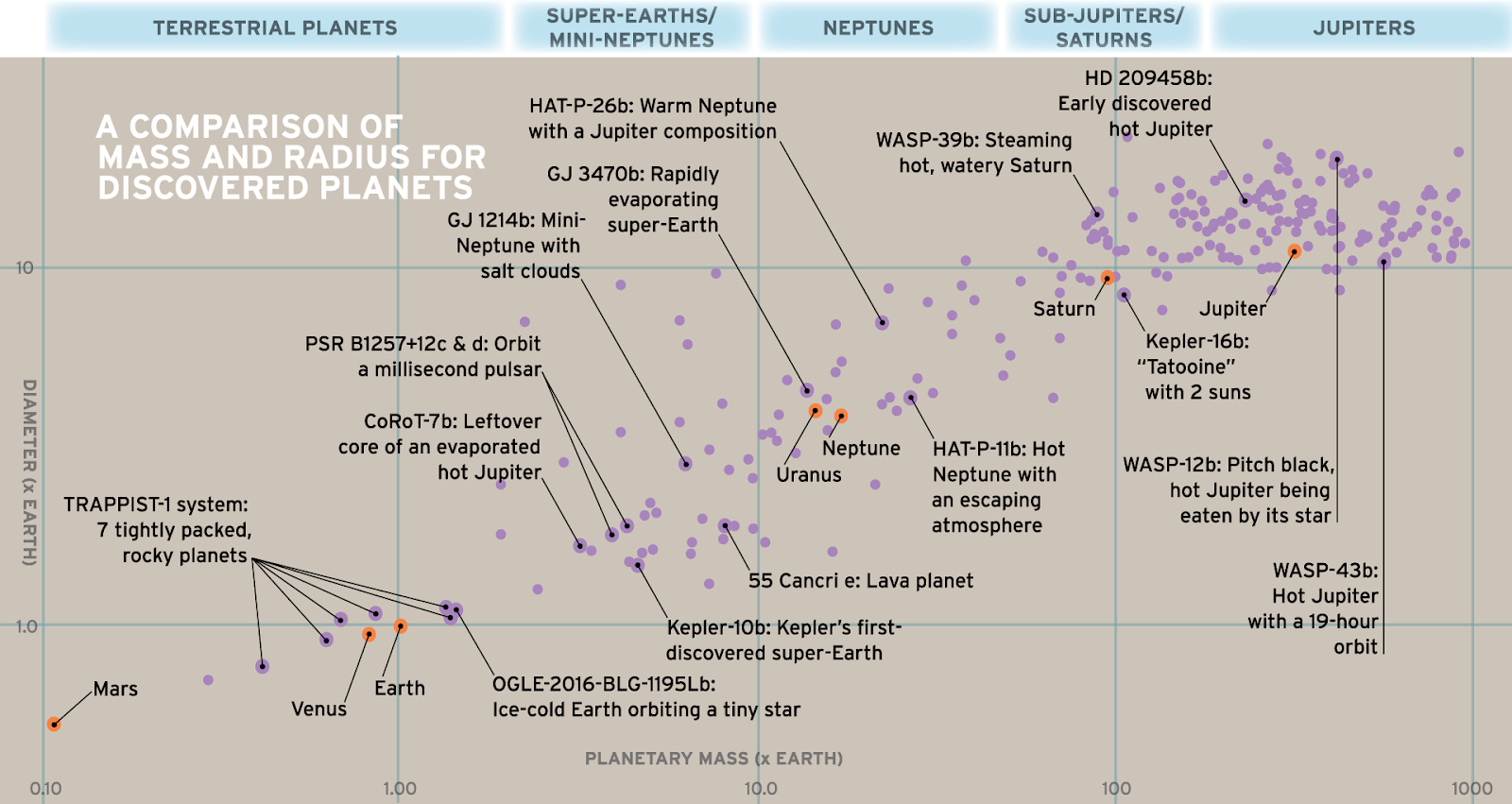
|
Before the onslaught of the extra-Solar planets, the party line was that planets formed at particular radii in the Solar Nebula and essentially spent their lives at around the same distance from the Sun. This position is no longer held by most people. The snowline in our planet forming disk is around 3-4 AU and it was expected that all Jovian planets in extra-Solar planetary systems would be found outside the snowlines of their disks. The discovery of so-many Jupiter-like planets close to their stars, inside the snowlines, suggested that planets likely migrate around their systems over their lifetimes. This notion has also influenced the modeling of our Solar System. Shown below is one of the proposed models for how our Solar System formed. The model is known as the Grand Tack Hypothesis.
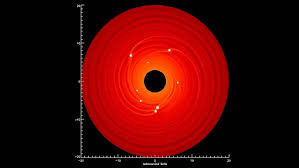
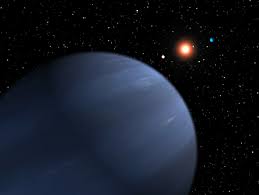 223 Kepler 223 Kepler |
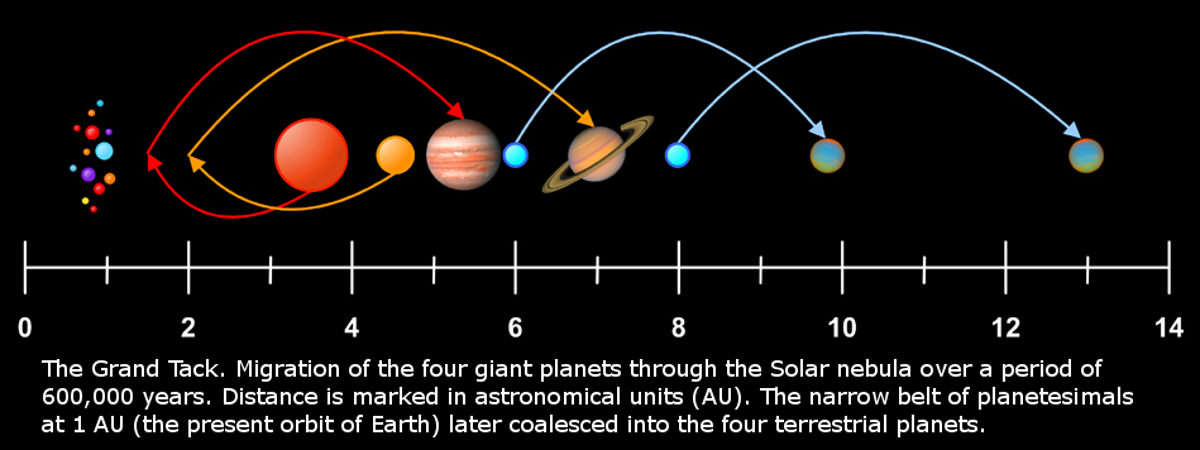 |
The current lore is that our basic notions about planetary system formation are probably okay in that we think the general ideas are correct. However, the current results suggest that after planets start to form, their orbits must somehow be modified so that Jupiter-like planets will be found close to their stars, within the zones where water would be in vapor form not solid form, that is, inside the snowlines in their systems. More extreme orbital migration than thought to happen in our Solar System must occur in planetary systems in general and is a topic of current research.

